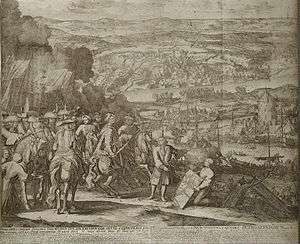Azov campaigns (1695–96)
| Azov campaigns (1695–96) | |||||||
|---|---|---|---|---|---|---|---|
| Part of Russo-Turkish War (1686–1700) | |||||||
 Taking of Azov, a 17th-century Dutch engraving | |||||||
| |||||||
| Belligerents | |||||||
|
|
| ||||||
| Commanders and leaders | |||||||
|
|
| ||||||
The Azov campaigns of 1695–96 (Russian: Азо́вские похо́ды), were two Russian military campaigns during the Russo-Turkish War of 1686–1700, led by Peter the Great and aimed at capturing the Turkish fortress of Azov (garrison - 7,000 men), which had been blocking Russia's access to the Azov Sea and the Black Sea. Since the Crimean campaigns of 1687 and 1689 had failed because of the difficulty of moving a large army across the steppe, Peter decided to try a river approach.
The first Azov campaign
The first Azov campaign began in the spring of 1695. Peter the Great ordered his army (31,000 men and 170 guns) to advance towards Azov. The army comprised crack regiments and the Don Cossacks and was divided into three units under the command of Franz Lefort, Patrick Gordon and Avtonom Golovin. Supplies were shipped down the Don from Voronezh. In 1693 the Ottoman garrison of the fortress was 3,656, of whom 2,272 were Janissaries.[3] Between June 27-July 5 the Russians blocked Azov from land but could not control the river and prevent resupply. After two unsuccessful attacks on August 5 and September 25, the siege was lifted on October 1.[4]
Another Russian army (120,000 men, mostly cavalry, Streltsy, Ukrainian Cossacks and Kalmyks) under the command of Boris Sheremetev set out for the lower reaches of the Dnieper to take the Ottoman forts there. The main fort at Gazi-Kerman was taken when its powder magazine blew up, as well as Islam-Kerman, Tagan and Tavan,[5] but the Russians were not able to hold the area and withdrew most of their forces. By the Treaty of Constantinople (1700) the remaining Russians were withdrawn and the lower Dnieper was declared a demilitarized zone.
The second Azov campaign
At the end of 1695 the Russians began preparing for the second Azov campaign. By the spring of 1696 they had built a fleet of ships to block Turkish reinforcements for the garrison.[6] The cavalry under the command of Sheremetev (up to 70,000 men) was once again sent to the lower reaches of the Dnieper. From April 23–26 the main forces (75,000 men) under the command of Aleksei Shein started to advance towards Azov by land and water (the rivers of Voronezh and Don). Peter I and his galley fleet left for Azov on May 3. On May 27 the Russian fleet (two ships-of-the-line, four fire ships, 23 galleys and miscellaneous vesselsa, built at Voronezh and nearby locations) under the command of Lefort reached the sea and blocked Azov. On June 14 the Turkish fleet (23 ships with 4,000 men) appeared at the mouth of the Don. However, it left after having lost two ships in combat. After massive bombardment from land and sea and seizure of the external rampart of the fortress by the Ukrainian and Don Cossacks on July 17, the Azov garrison surrendered on July 19.[7]
Aftermath
The Azov campaigns demonstrated the significance of having a fleet and marked the beginning of Russia's becoming a maritime power. Russia's success at Azov strengthened its positions during the Karlowitz Congress of 1698-1699 and favored the signing of the Treaty of Constantinople in 1700. As Azov's harbor was not convenient for the military fleet, the Tsar selected another more appropriate site on July 27, 1696, on the cape Tagan-Rog (Taganrog). On September 12, 1698, Taganrog was founded there, which became the first military base of the Russian Navy.
Although the campaign was a success, it was evident to Peter I of Russia that he achieved only partial results, since his fleet was bottled up in the Sea of Azov due to Crimean and Ottoman control of the Strait of Kerch. A regular navy and specialists who could build and navigate military ships were necessary for resisting the Ottoman attacks. On October 20, 1696, the Boyar Duma decreed the creation of the regular Imperial Russian Navy; this date is considered to be the birthdate of the Russian Navy. The first shipbuilding program consisted of 52 vessels.
Notes
- ↑ Brian Davies, Warfare, State and Society on the Black Sea Steppe, 1500–1700, (Routledge, 2007), 185.
- ↑ The Crimean Tatars and the Austro-Ottoman Wars, Dan D.Y. Shapira, The Peace of Passarowitz, 1718, ed. Charles W. Ingrao, Nikola Samardžić, Jovan Pesalj, (Purdue University Press, 2011), 135.
- ↑ Rhoads Murphey, Ottoman Warfare 1500-1700, (UCL Press Limited,1999), 55.
- ↑ Brian Davies, Warfare, State and Society on the Black Sea Steppe, 1500–1700, 185.
- ↑ The Crimean Tatars and the Austro-Ottoman Wars, Dan D.Y. Shapira, The Peace of Passarowitz, 1718, 135.
- ↑ William Young, International Politics And Warfare In The Age Of Louis XIV and Peter the Great, (iUniverse, 2004), 439.
- ↑ The Crimean Tatars and the Austro-Ottoman Wars, Dan D.Y. Shapira, The Peace of Passarowitz, 1718, 135.
References
- Brian L. Davies: Warfare, State and Society on the Black Sea Steppe 1500-1700, Oxon 2007. Google-Books-Link